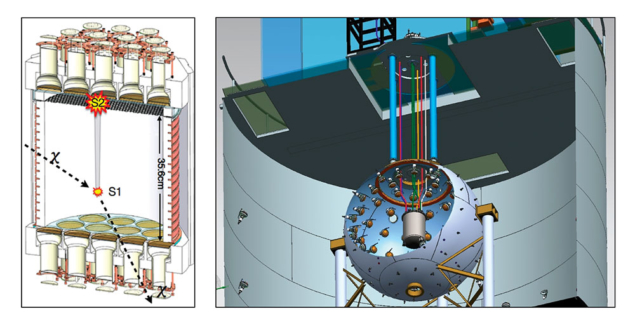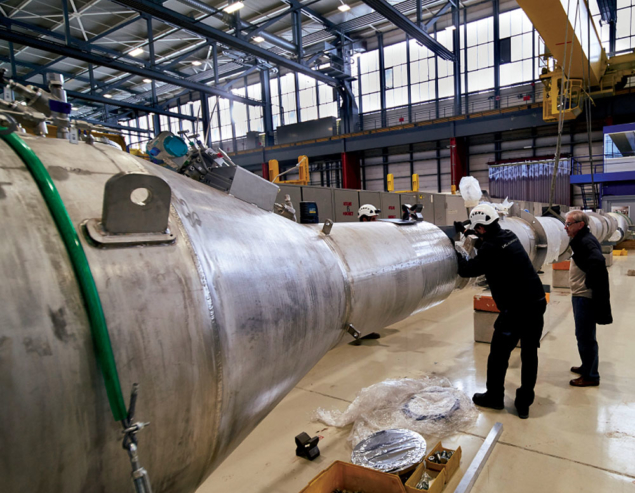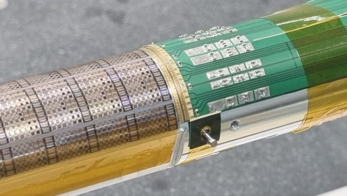A global effort is under way to carry out a complete search for high-mass dark-matter particles using an experiment called DarkSide-20k and its successor, which rely on novel liquid-argon technologies.

Compelling cosmological and astrophysical evidence for the existence of dark matter suggests that there is a new world beyond the Standard Model of particle physics still to be discovered and explored. Yet, despite decades of effort, direct searches for dark matter at particle accelerators and underground laboratories alike have so far come up empty handed. This calls for new and improved methods to spot the mysterious substance thought to make up most of the matter in the universe.
Dark-matter searches using detectors based on liquefied noble gases such as xenon and argon have long demonstrated great discovery potential and continue to play a major role in the field. Such experiments use a large volume of material in which nuclei struck by a dark-matter particle would create a tiny burst of scintillation light, and the very low expected event rate requires that backgrounds are kept to a minimum. Searches employing argon detectors have a particular advantage because they can significantly reduce events from background sources, such as background from the abundant radioactive decays from detector materials and from electron scattering by solar neutrinos. That will leave the low-rate nuclear recoils induced by coherent scattering of atmospheric neutrinos as the sole residual background – the so-called “neutrino floor”.
Enter the Global Argon Dark Matter Collaboration (GADMC), which was formed in September 2017. Comprising more than 300 scientists from 15 countries and 60 institutions involved in four first-generation dark-matter experiments – ArDM at Laboratorio Subterráneo de Canfranc in Spain, DarkSide-50 at INFN’s Laboratori Nazionali del Gran Sasso (LNGS) in Italy, DEAP-3600 and MiniCLEAN at SNOLAB in Canada – GADMC is working towards the immediate deployment of a dark-matter detector called DarkSide-20k. The experiment would accumulate an exposure of 100 tonne × year and be followed by a much larger detector to collect more than 1000 tonne × year, both potentially with no instrumental background. These experiments promise the most complete exploration of the mass/parameter range of the present dark-matter paradigm.
Direct detection with liquid argon
One well-considered form of dark matter that matches astronomical measurements is weakly interacting massive particles (WIMPs), which would exist in our galaxy with defined numbers and velocities. In a dark-matter experiment employing a liquid-argon detector, such particles would collide with argon nuclei, causing them to recoil. These nuclear recoils produce ionised and excited argon atoms which, after a series of reactions, form short-lived argon dimers (weakly bonded molecules) that decay and emit scintillation light. The time profile of the scintillation light is significantly different from that created by argon-ionising events associated with radioactivity in the detector material, and has been shown to enable a strong rejection of background sources through a technique known as pulse-shape discrimination.

Located at LNGS, DarkSide-50 is the first physics detector of the DarkSide programme for dark-matter detection, with a fiducial mass of 50 kg. The experiment produced its first WIMP search results in December 2014 using argon harvested from the atmosphere and, in October the following year, reported the first ever WIMP search results using lower-radioactivity underground argon.
DarkSide-50 uses a detection scheme based on a dual-phase time projection chamber (TPC), which contains a small region of gaseous argon above a larger region of liquid argon (figure 1, left). In this configuration, secondary scintillation light, generated by ionisation electrons that drift up through the liquid region and are accelerated into the gaseous one, are used together with the primary scintillation light to look for a signal. Compared to single-phase detectors using only the pulse-shape discrimination technique, this search method requires even greater care in restricting the radioactive background through detector design and fabrication but provides excellent position resolution. For low-mass (<10 GeV/c2) WIMPs, the primary scintillation light is nearly absent, but the detectors remain sensitive to dark matter through the observation of the secondary scintillation light.

Argon-based dark-matter searches have had a number of successes in the past two years (figure 2). DarkSide-50 established the availability of an underground source of argon strongly depleted in the radioactive isotope 39Ar, while DEAP-3600 (figure 3), the largest (3.3 tonnes) single-phase liquid-argon running experiment, provided the best value to date on the precision of pulse-shape discrimination for scintillation light, better than 1 part in 109. In terms of measurements, DarkSide-50 released results from a 500-day detector exposure completely free of instrumental background and set the best exclusion limit yet for interactions of WIMPs with masses between 1.8 and 6 GeV/c2. Similar results to those from Darkside-50 for the mass region above 40 GeV/c2 were reported in the first paper from DEAP-3600, and results from a one-year exposure of DEAP-3600 with a fiducial mass of about 1000 kg are expected to be released in the near future.
High-sensitivity searches for WIMPs using noble-gas dual-phase TPC detectors are complementary to searches conducted at the Large Hadron Collider (LHC) in the mass region accessible at the current LHC energy of 13 TeV (which is limited to masses of a few TeV/c2) and can reach masses of 100 TeV/c2 and beyond with very good sensitivity.
Leading limits
The best limits to date on high-mass WIMPs have been provided by xenon-based dual-phase TPCs – the leading result given by the recently released XENON1T exposure of 1 tonne × year (figure 2). In spite of a small residual background, they were able to exclude WIMP-nucleon spin-independent elastic-scatter cross-sections above 4.1 × 10–47 cm2 at 30 GeV/c2 at 90% confidence level (CERN Courier July/August 2018 p9). Larger xenon detectors (XENONnT and DARWIN) are also planned by the same collaboration (CERN Courier March 2017 p35).

The next generation of xenon and argon detectors have the potential to extend the present sensitivity by about a factor of 10. But there is still a further factor of 10 to be increased before one reaches the neutrino floor – the ultimate level at which interactions of solar and atmospheric neutrinos with the detector material become the limiting background. This is where the GADMC liquid-argon detectors, which are designed to have pulse-shape discrimination capable of eliminating the background from electron scatters of solar neutrinos and internal radioactive decays, can provide an advantage.
GADMC envisages a two-step programme to explore high-mass dark matter. The first step, DarkSide-20k, has been approved for construction at LNGS by Italy’s National Institute for Nuclear Physics (INFN) and by the US National Science Foundation, with present and potentially future funding from Canada. Also a recognised experiment at CERN called RE-37, DarkSide-20k is designed to collect an exposure of 100 tonne × year in a period of five years (to be possibly extended to 200 tonne × year in 10 years), completely free of any instrumental background. The start of data taking is foreseen for 2022–2023. The second step of the programme will involve building an argon detector that is able to collect an exposure of more than 1000 tonne × year. SNOLAB in Canada is a strong candidate to host this second-stage experiment.
Argon can deliver the ultimate background-free search for dark matter, but that comes with extensive technological development. First and foremost, researchers need to extract and distill large volumes of the gas from underground deposits, as argon in the Earth’s atmosphere is unsuitable owing to its high content of the radioactive isotope 39Ar. Second, the scintillation light has to be efficiently detected, requiring innovative photodetector R&D.
Sourcing pure argon
Focusing on the first need, atmospheric argon has a radioactivity of 1 Bq/kg, which is entirely caused by the activation of 40Ar by cosmic rays. Given that the drift time of ionisation electrons over a length of 1 m is 1 ms, a dual-phase TPC detector reaches a complete pile-up condition (i.e. when the event rate exceeds the detector’s ability to read out the information), at a mass of 1 tonne. Scintillation-only detectors do not fare much better, and given that the scintillation lifetime is 10 μs, they are limited to detectors with a fiducial mass of a few tonnes. The argon road to dark matter has thus required early concentration on solving the problem of procuring large batches of argon that are much more depleted in 39Ar than atmospheric argon is. The solution came through an unlikely path: the discovery that underground sources of CO2 originating from Earth’s mantle carry sizable quantities of noble gases, in reservoirs where secondary production of 39Ar is significantly suppressed.
As part of a project called Urania, funded by INFN, GADMC will soon deploy a plant that is able to extract underground argon at a rate of 250 kg per day from the same site in Colorado, US, where argon for DarkSide-50 was extracted. Argon from this underground source is more depleted in 39Ar than atmospheric argon by a factor of at least 1400, making detectors of hundreds of tonnes possible for high-mass WIMP searches.
Not content with this gift of nature, another project called ARIA, also funded by INFN, by the Italian Ministry of University and Research (MIUR), and by the local government of the Sardinia region, is developing a further innovative plant to actively increase the depletion in 39Ar. The plant will consist of a 350 m-tall cryogenic-distillation tower called Seruci-I, which is under construction in the Monte Sinni coal mine in Sardinia operated by the Carbosulcis mining company. Seruci-I will study the active depletion of 39Ar by cryogenic distillation, which exploits the tiny dependence of the vapour pressure upon the atomic number. Seruci-I is expected to reach a production capacity of 10 kg of argon per day with a factor of 10 of 39Ar depletion per pass. This is more than sufficient to deliver – starting from the gas extracted with the Urania underground source – a one-tonne ultra-depleted-argon target that could enable a leading programme of searches for low-mass dark matter. Seruci-I is also expected to perform strong chemical purification at the rate of several tonnes per day and will be used to perform the final stage of purification for the 50 tonne underground argon batch for DarkSide-20k as well as for GADMC’s final detector.

CERN plays an important role in DarkSide-20k by carrying out vacuum tests of the 30 modules for the Seruci-I column (figure 4) and by hosting the construction of the cryogenics for DarkSide-20k. At the time of its approval in 2017, DarkSide-20k was set to be deployed within a very efficient system of neutron and cosmic-ray rejection, based on that used for DarkSide-50 and featuring a large organic liquid scintillator detector hosted within a tank of ultrapure deionised water. But with the deployment of new organic scintillator detectors now discouraged at LNGS due to tightening environmental regulations, GADMC is completing the design of a large, and more environmentally friendly, liquid-argon detector for neutron and cosmic-ray rejection based on the cryostat technology developed at CERN to support prototype detector modules for the future Deep Underground Neutrino Experiment (DUNE) in the US.
Turning now to the second need of a background-free search for dark matter – the efficient detection of the scintillation light – researchers are focusing on perfecting existing technology to make low-radioactivity silicon photomultipliers (SiPMs) and using them to build large-area photosensors that are capable of replacing the traditional 3″ cryogenic photomultipliers. Plans for DarkSide-20k settled on the use of so-called NUV-HD-TripleDose SiPMs, designed by Fondazione Bruno Kessler of Trento, Italy, and produced by LFoundry of Avezzano, also in Italy. In the meantime, researchers at LNGS and other institutions succeeded in overcoming the huge capacitance per unit surface (50 pF/mm2) required to build photosensors that have an area of 25 cm2 and deliver a signal-to-noise ratio of 15 or larger. A new INFN facility, the Nuova Officina Assergi, was designed to enable the high-throughput production of SiPMs to make such photosensors for DarkSide-20k and future detectors, and it is now under construction.
GADMC’s programme is complemented by a world-class effort to calibrate noble-liquid detectors for low-energy nuclear recoils created by low-mass dark matter. On the heels of the SCENE programme that took place at the University of Notre Dame Tandem accelerator in 2013–2015, the R&D programme, developed at the University of Naples Federico II and now installed at the INFN Laboratori Nazionali del Sud, plans to improve the characterisation of the argon response to nuclear recoils. Of special interest is the extension of measurements to 1 keV, in support of searches for low-mass dark matter, and the verification of the possible dependence of the nuclear-recoil signals upon the direction of the initial recoil momentum relative to the drift electric field, which would enable measurements below the neutrino floor. Directionality in argon has already been established for alpha particles, protons and deuterons, and its presence for nuclear recoils was hinted at by the last results of the SCENE experiment.
Although only recently established, GADMC is enthusiastically pursuing this long-term, staged approach to dark-matter detection in a background-free mode, which has great discovery potential extending all the way to the neutrino floor and perhaps beyond.
Further reading
DEAP-3600 Collaboration 2018 Phys. Rev. Lett. 121 071801.
DarkSide Collaboration 2018 Phys. Rev. Lett. 121 111303.
DarkSide Collaboration 2018 Phys. Rev. Lett. 121 081307.
DarkSide Collaboration 2018 Eur. Phys. J. Plus 133 131.





